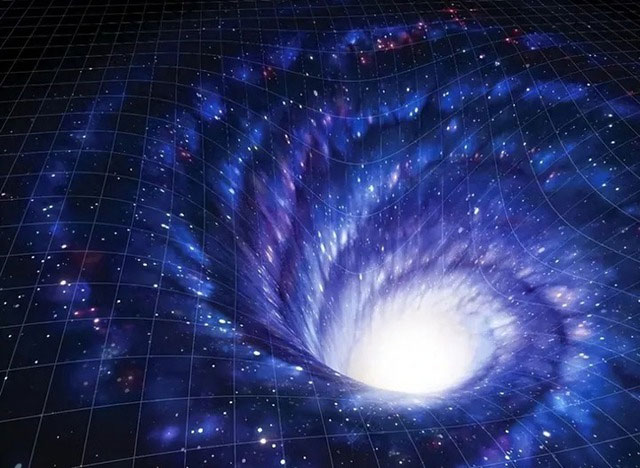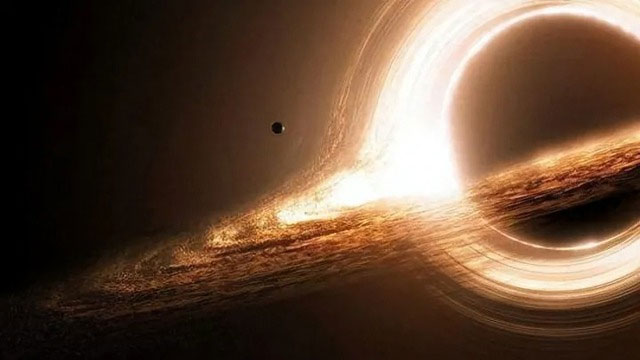What would you see if you fell into a black hole?
Black holes are one of the most mysterious and fascinating entities in the universe. Countless scientists have worked hard to uncover the mysteries of black holes.
But what do we see when we are caught in the gravitational whirlpool of a black hole? This question has remained a cosmological mystery until recently. Now, we finally have the opportunity to peer into the mystery of black holes and explore the secret worlds hidden deep within the universe.

Einstein's general theory of relativity revealed that the essence of gravity is the curvature of space-time, and black holes are actually an extreme phenomenon of space-time curvature. (Photo: Zhihu)
The formation of black holes is primarily associated with the death of stars. At a certain stage in a star's evolution, when nuclear fusion stops and the star runs out of fuel, its inner core will be unable to resist its own gravity and collapse. This process is called the star's "core collapse."
After the core collapses, the size of the star decreases sharply and the mass is concentrated into a very small space. When the core mass reaches a certain critical point, the gravitational force will no longer be able to be resisted by any force and the star will completely collapse into an extremely compact celestial body, forming a new black hole.

The strong gravitational force created by a black hole causes the surrounding space-time to bend to an extreme extent, forming a boundary called the "event horizon" from which any matter and information that crosses this boundary cannot escape. (Photo: Zhihu).
Types of black holes
According to the formation method and properties of black holes, we can divide black holes into three types: stellar mass black holes, intermediate mass black holes and supermassive black holes.
- Stellar mass black holes are black holes with masses about 10 times that of the Sun, formed by the collapse of stars. This type of black hole is the most common and many of these black holes have been discovered to date.
- Intermediate-mass black holes lie between stellar-mass black holes and supermassive black holes, with masses ranging from a few thousand to a million times that of the Sun. However, there is still some debate among scientists about how such black holes form.
- Supermassive black holes are the most massive black holes in the universe, with masses ranging from millions to billions of times that of the Sun. Scientists believe they may have formed through some special mechanism, such as the merger of galaxies or the collapse of scales at the center of galaxies.

The larger a black hole is, the stronger its gravitational pull becomes. Inside a black hole's event horizon, gravity is so strong that not even light can escape. This makes a black hole the most powerful gravitational trap in the universe, attracting and swallowing nearby matter and galaxies. Photo: Zhihu
Harsh Environment and Amazing Scenes of Falling into a Black Hole
When an object falls into a black hole, it will experience a series of harsh environments and incredible scenes. First, the gravitational field will increase rapidly, creating a huge gravitational gradient. This gravitational gradient is so great that even the strongest matter will be torn into atomic-sized pieces. Neither rock, metal, nor the human body can survive the gravitational pull of a black hole.
Things get even weirder when an object enters the boundary of a black hole, known as the 'event horizon' . Due to the curvature of gravity, light is bent, creating unusual visual effects. As an object approaches a black hole, the light is distorted into strange shapes that look like mirage beams. These beams are called 'gravitational lensing' and are a true manifestation of the black hole's powerful gravitational field.
Within the event horizon, time also becomes incredibly distorted. The effects of relativity make time pass slowly relative to the outside world, which means that time near the black hole appears to the outside world to be extremely long. For objects falling into the black hole, time may pass in a moment, but to the outside world, years or hundreds of years may have passed.

A black hole accretion disk is a ring-shaped disk of material that is pulled into the black hole by nearby matter and generates high temperatures and radiation due to friction. These studies provide important clues for us to explore the movement of matter around the black hole and estimate the mass of the black hole. (Image: Zhihu).
Objects that go deeper into a black hole face more extreme conditions. The center of a black hole, known as a 'singularity,' is a place that cannot be explained by our understanding of physics. It is a place of infinite density and gravity but infinitely small volume. Here, the laws of classical physics break down, and a combination of quantum mechanics and general relativity becomes the only theory that can explain the nature of black holes.
Given these extreme environments and incredible landscapes, matter falling into a black hole would no longer exist in our familiar universe. It could disappear completely or become part of the black hole . We don't have a definitive answer about the ultimate fate of matter in a black hole, which adds to the mystery of black holes.
Although black holes are some of the most mysterious places in the universe, our understanding of them is still limited . Scientists are working hard to study the nature and behavior of black holes in the hope of revealing the secrets they hide. By observing the radiation around black holes and using advanced simulation techniques, we can gain a deeper understanding of the extreme environments and incredible sights that matter facing when falling into a black hole faces.

Through observations of black hole merger events, scientists have discovered that black hole mergers occur frequently in the universe. These black hole merger events are the product of giant gravitational wave explosions in the universe, and the gravitational wave pulses they create can be recorded by gravitational wave detectors on Earth. By observing and analyzing these gravitational wave events, scientists can study the formation and evolution of black holes as well as the structure of the universe. (Photo: Zhihu).
- Discover the mystery of the most exotic black holes in the universe
- 740 million light years away is a completely different universe of black holes
- Discovering 'super black holes' is 12 times bigger than the Sun.
- Evidence of the power of black holes
- Black hole detection
- What if you fell into a black hole in the universe?
- Video: Top 5 biggest black holes discovered by NASA in 2017
- The galaxy's giant black hole
- The first time I took a picture of a black hole three million times bigger than Earth
- The supermassive black hole was discovered 34 billion times larger than the Sun.
- Black holes may have grown differently when the universe was 'younger'
- Monster black hole 'belching' twice after swallowing gas
 Van Allen's belt and evidence that the Apollo 11 mission to the Moon was myth
Van Allen's belt and evidence that the Apollo 11 mission to the Moon was myth The levels of civilization in the universe (Kardashev scale)
The levels of civilization in the universe (Kardashev scale) Today Mars, the sun and the Earth are aligned
Today Mars, the sun and the Earth are aligned The Amazon owner announced a secret plan to build a space base for thousands of people
The Amazon owner announced a secret plan to build a space base for thousands of people